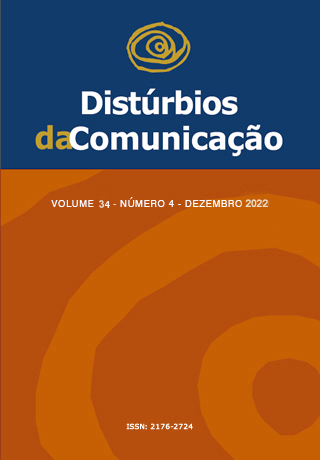Characteristics of oral and written communication in adults living in a long-stay institution
DOI:
https://doi.org/10.23925/2176-2724.2022v34i4e56668Keywords:
Mental Health, Aged, Homes for the AgedAbstract
Introduction: The need to change the conception of society about individuals with mental disorders and reinsert them in social spaces is increasingly evident, especially when they live in a long-term care institution (LTCI). Objective: To characterize different ways in which individuals living in a LTCI communicate, expressing their uniqueness through the mediation of oral and written language during workshops. Methods: Descriptive qualitative study. The Mini Mental State Examination (MMSE) was used for initial screening and oral and written language workshops were held with residents of a LTCI. Data were registered in a field diary and categorized and exemplified with the records made. Results: 25 workshops were held, in which the possibilities of communication between participants through oral and written language were sought, with emphasis on the stimulation of cognitive skills of attention and memory. Facts were extracted that allowed them to be divided into six categories, demonstrating that individuals with mental disorders can communicate in different ways, be understood and belong to the space they are inserted in, providing a collective construction of knowledge and experiences. Conclusions: Through communication, it is possible to develop cognitive, social and oral language, contributing to the improvement of quality of life, valuing those involved as social and historical subjects. In multi and interdisciplinary work in LTCI for adults with mental disorders, Speech-Language Therapy finds favorable shapes for the work on the cognitive and linguistic aspects of the subjects in question.
Downloads
References
Amarante P, Nunes MO. A reforma psiquiátrica no SUS e a luta por uma sociedade sem manicômios. Ciênc. Saúde Colet. 2018; 23(6): 2067-74.
Martins RCA. Reformas psiquiátricas e o processo de ressignificação do trabalho na saúde mental. Rev. Nufen: Phenom. Interd. 2019;11(2): 96-116.
Brasil. Lei nº 10.216, de 6 de abril de 2001. Código Civil. Diário Oficial da União 9 abr 2001; seção 1, p.2.
ONU. Declaração Universal dos Direitos Humanos. Assembleia Geral das Nações Unidas. Brasil, Rio de Janeiro, 2009. Disponível em: Acesso em: 10 mar. 2020.
Nascimento LA, Leão A. Estigma social e estigma internalizado: a voz das pessoas com transtorno mental e os enfrentamentos necessários. História, Ciências, Saúde–Manguinhos. 2019; 26(1): 103-21.
Pretto DS, Tisott ZL, Freitas FG, Terra MG, Mello AL, Pires FB, et al. Cuidado às pessoas com transtorno mental: significados atribuídos por trabalhadores de uma instituição de longa permanência. Res., Soc. Dev. 2019; 8(11): 1-16.
DSM-V. Manual diagnóstico e estatístico de transtornos mentais. 5ª ed. Porto Alegre: Artmed; 2014.
Almeida BPB, Cunha MC, de Paula Souza LA. Speech Therapy and Mental Health: Service Group to Institutionalized Individuals with Mental Disorders. GKA revMEDICA [Internet]. 2015; 4(2).
Folstein M, Folstein S, McHugh P. “Mini-mental state”. A practical method for grading the cognitive state of patients for the clinician. J Psychiatr Res 1975; 12(3):189-198.
Brucki SMD, Nitrini R, Caramelli P, Bertolucci PHF, Okamoto IH. Sugestões para o uso do mini-exame do estado mental no Brasil.
Arq Neuropsiquiatr. 2003; 61(3-B): 777-81.
Carlomagno MC, Rocha LC. Como criar e classificar categorias para fazer análise de conteúdo: Uma questão metodológica. Revista Eletrônica de Ciência Política. 2016; 7(1): 173-88.
Santos AE, Pedrão LJ, Amorim NEZ, Carvalho AMP, Bárbaro AM. Comportamento comunicativo de indivíduos com diagnóstico em esquizofrenia. Rev. CEFAC. 2014;16(4):1283-93.
Soares SJ, Fonseca VM. Pesquisa científica: uma abordagem sobre a complementaridade do método qualitativo. Quaestio [Internet]. 2019; 21(3): 865-81.
Carvalho AFT, Peixoto ERS. Memória na Prática da Terapia Ocupacional e da Fonoaudiologia. Rio de janeiro: Editora Rubio; 2012.
Izquierdo I. Memória. 2ª ed. rev. e ampl. Porto Alegre: Artmed, 2011.
Vygotski LS. A formação social da mente. São Paulo: Martins Fontes, 1984.
Falci DM, Mambrini JVM, Costa EC, Firmo JOA, Costa MFL, Filho AIL. Uso de psicofármacos prediz incapacidade funcional entre idosos. Rev. Saúde Pública. 2019; 53(21):1-12.
Léxico. Dicionário de português onlin [Acesso em 18 abr 2020]. Disponível em: https://www.lexico.pt/associar/.
Matta APC, Chiacchio SVB, Leyser M. Possíveis etiologias da síndrome de West Avaliação de 95 pacientes. Arq neuropsiquiatr. 2007;v. 65(3): 659- 62.
Gonçalves DLC. Investigações sobre o conceito de metáfora. Revista Eletrônica de Filosofia. 2018;15(1): 83-95.
Koehler C, Gindri G, Bós ANG, Mancopes R. Alterações de linguagem em pacientes idosos portadores de demência avaliados com a Bateria MAC. Rev Soc Bras Fonoaudiol. 2012;17(1): 15-22.
Mantovani MS, Ribeiro MCP. A influência da comunicação não verbal na interação humana. Rev. Univ. Vale Rio Verde (Online). 2018; 16(2):1-10
Paes PCD. Superior psychological functions and the rooting of culture in individuality. Braz. J. of Develop. 2020; 6(7): 43489-500.
Downloads
Published
Issue
Section
License
Copyright (c) 2023 Brunna Coutinho, Gabriel Trevizani Depolli, Larissa Bassan

This work is licensed under a Creative Commons Attribution 4.0 International License.









